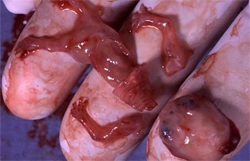Not all ovarian cysts are tumors, to remove which you have to go to the surgical table. Approximately in seven of the ten cases, a cyst detected by a woman relates to a functional, and undergoes in itself with the beginning of the next menstrual cycle.
Content
 Beat the alarm, doctors begin when the cyst is preserved longer, causes pain or bleeding. In these cases, it will certainly need to explore. In most cases, using an ultrasound examination, it is possible to find out its type, dimensions and probability of rebirth in malignant.
Beat the alarm, doctors begin when the cyst is preserved longer, causes pain or bleeding. In these cases, it will certainly need to explore. In most cases, using an ultrasound examination, it is possible to find out its type, dimensions and probability of rebirth in malignant.
Once a month in the body of each woman, a benign cyst is formed in the ovary - a tiny bag-capsule, filled with liquid, or follicle. When an egg ripen inside it, the follicle shell is broken, the release of the egg outward. In the event that ovulation for any reason does not occur, the follicle can continue to grow, forming the cyst. Since it is formed from normal tissues, monthly changing during ovulation, it is called functional cyst and usually disappears before the next menstrual cycle.
Another physiological variety of cysts can develop in a small cavity formed in the ovary after displacing the eggs. These cavities are filled with blood vessels and new cells in order to form a yellow body producing a hormone progesterone. As a rule, yellow bodies exist within two weeks, and then, if pregnancy does not occur, they are moving, forming a tiny scar. But if the surface of the ovary is bleeding and blood gets into the yellow body, a cyst can form, filled with blood. She also usually disappears in one or two months.
Most often, the appearance of a functional cyst is a consequence of hormonal imbalance, and its treatment is based on the normalization of the hormonal background. All this time, the pile is carefully watching. If within three months it does not disappear and does not detect any tendencies to decrease, you have to resort to surgical treatment.
In addition to functional cyst, there are true tumors - cystomas. Whatever their origin (endometrium, dermoid), the presence of such entities in the body inspires greater anxiety, as they can be in a border state or go to malignant. In this case, avoid surgical treatment will not be able to.
The ovarian cyst may discovered in a woman at any age, but after 40 years the probability of the disease increases noticeably. The trouble is that the resulting cyst is in no hurry to declare his existence. Most ovarian cysts do not cause any symptoms, and a woman may not even suspect of its existence until the doctor finds the cyst during the usual preventive inspection or using ultrasound. That is why it is so important to inspect the gynecologist at least once a year.
Only when cystic tumors grow too large, they can start putting on the bladder, intestines or abdominal wall. Very rarely, such a cyst may cause sudden severe pain, the delay of the next menstruation or on the contrary, the incessant discharge.
In any case, it is best to immediately deal with the reasons for these phenomena, contacting the gynecologist.









